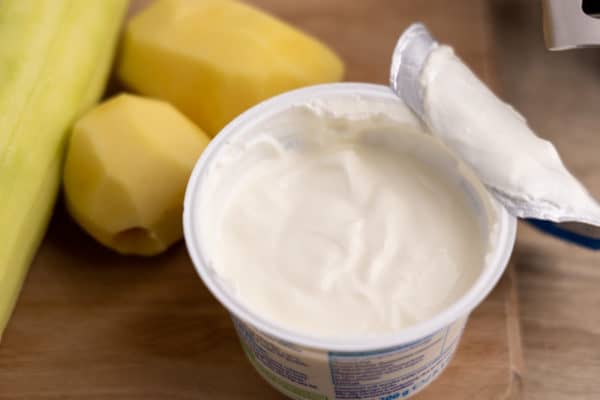“Gently” is the keyword when it comes to heating up sour cream, whether you heat it separately or along with other ingredients. Its important, too, to know whether your sour cream is full fat, light or nonfat because each type of sour cream reacts to heat differently. Even though heating sour cream may be tricky, its lively tang and its creaminess makes many foods taste better, from entrees to soups and sauces.
However, it’s important to note that excessive heat can also have negative effects on sour cream. If heated for too long or at too high a temperature, the proteins in the sour cream can coagulate and form lumps. This can result in a grainy texture and an unpleasant mouthfeel.

Uses for Heated Sour Cream
Cupfuls of warm sour cream works in entrees such as chicken or beef stroganoff, green-bean casserole and macaroni and cheese, and by tablespoon-full stirred into soups and sauces. A warm sour cream sauce works well with dill, capers and cucumbers for salmon and other fish and with whole-grain or Dijon mustard for a sauce to pour over pork or poultry. You could even make a caramel sauce for desserts using sour cream instead of heavy cream.
When heating sour cream in the microwave, you can control time and intensity. This method works for making sour cream sauces and for bringing sour cream up to room temperature before adding it to hot food on the stove top — a procedure that prevents it from curdling. For each tablespoon of sour cream, microwave it first for 15 seconds at high power or for 20 seconds at 90-percent power. Then microwave in five-second intervals, checking on the sour cream between each interval until it becomes very warm. Stop microwaving before the sour cream becomes hot.
Heating With Other Ingredients
In addition to bringing it to room temperature before adding it to other ingredients on the stove top, temper sour cream by stirring a small amount of the hot ingredient into the sour cream before adding it to the entire casserole or soup. Add sour cream just before serving a dish and gently heat the dish on low heat, well short of the boiling point.
To minimize the chances of sour cream curdling when you add it to a hot dish on the stove top, choose full-fat or low-fat sour cream for heating since nonfat versions curdle more easily. Or add a tablespoon or so of flour to the dish, which also minimizes the chances of curdling. To help prevent curdling, Cooking Light recommends you check the temperature of your soup or entree with an instant-read thermometer and only add the sour cream when the temperature is below 180 degrees Fahrenheit.
If sour cream develops small, white lumps instead of a smooth, creamy texture, it has curdled. The food still is safe to eat. You can try to thicken it to remove the lumps or eat it as is, enjoying the flavor of the dish if not the appearance. For soups and sauces, mix a tablespoon of flour or cornstarch and a few teaspoons of the hot liquid. Stir this slurry into the soup and cook the mix for a few more minutes to thicken the dish.
Susan Lundman began writing about her love of cooking, ingredient choices, menu planning and healthy eating after working for 20 years on childrens issues at a nonprofit organization. She has written about food online professionally for ten years on numerous websites, and has provided family and friends with homemade recipes and stories about culinary adventures. Lundman received her M.A. from Stanford University.
Can sour cream go bad?
FAQ
Is it safe to heat up sour cream?
Is sour cream good warm?
Will sour cream break when heated?
Can you make sour cream hot?
Can sour cream be heated?
Fat-free or low-fat creams don’t tolerate heat as well as fuller fat versions – and even they have to be gentled. If you will be heating non-fat sour cream, it’s best to heat it for just a few seconds at a time, stirring as you go to try and prevent it from curdling and separating. Can you freeze sour cream?
What is the healthier substitute of sour cream?
The several good dairy options for replacing sour cream are: 1. Greek yogurt: It is lower in calories and fat and higher in protein that full fat sour cream. 2. Cottage cheese: Cottage cheese is a soft, mild cheese that is lower in calories and fat and significantly higher in protein that sour cream. It can be combined with milk and lemon juice to be used in place of sour cream. 3. Fresh cream: It is very similar to sour cream but higher in fat and calories. 4. Buttermilk: It is a tangy liquid that can be used as a replacement for sour cream in baked goods or dressings.
What happens if sour cream goes bad?
When sour cream goes bad, it can develop an off odor, a sour taste, or a change in texture, such as becoming lumpy or watery. These are all signs that sour cream is no longer safe to eat. If you eat bad sour cream, you may experience symptoms such as nausea, vomiting, diarrhea, abdominal cramps, and a general feeling of illness.
Can you eat warm sour cream?
If the sour cream was exposed to a temperature of more than 90 degrees Fahrenheit for a longer period of time, the fermented cream will spoil and develop harmful pathogens. So can you eat warm sour cream then? Well depends on your preferences, really.
